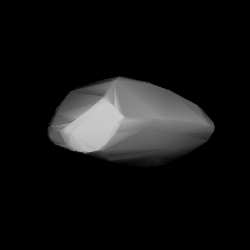
9994 Grotius, provisional designation 4028 P-L, is a stony Rafita asteroid from the middle regions of the asteroid belt, approximately 3.5 kilometers in diameter. It was discovered during the Palomar–Leiden survey in 1960, and named after Dutch jurist Hugo Grotius.
2751 Campbell, provisional designation 1962 RP, is a stony Nysian asteroid from the inner regions of the asteroid belt, approximately 6 kilometers in diameter.
8776 Campestris, provisional designation 2287 T-3, is a stony background asteroid from the central region of the asteroid belt, approximately 10 kilometers in diameter. It was discovered on 16 October 1977, by Dutch astronomer couple Ingrid and Cornelis van Houten at Leiden Observatory, and Dutch–American astronomer Tom Gehrels at the Palomar Observatory in California, United States. The asteroid was named for the tawny pipit, a shorebird.

9912 Donizetti, provisional designation 2078 T-3, is a stony Rafita asteroid from the central regions of the asteroid belt, approximately 7 km in diameter. It was discovered during the third Palomar–Leiden Trojan survey in 1977, and named after Italian composer Gaetano Donizetti.

9910 Vogelweide, provisional designation 3181 T-2, is a stony Koronian asteroid and elongated slow rotator from the outer regions of the asteroid belt, approximately 5 kilometers in diameter. It was discovered during the second Palomar–Leiden trojan survey in 1973, and named after German medieval poet Walther von der Vogelweide.
8121 Altdorfer, provisional designation 2572 P-L, is a stony Flora asteroid from the inner regions of the asteroid belt, approximately 2 kilometers in diameter. Discovered during the Palomar–Leiden survey in 1960, the asteroid was later named for Renaissance painter Albrecht Altdorfer.
5655 Barney, provisional designation 1159 T-2, is a Maria asteroid from the central regions of the asteroid belt, approximately 6.5 kilometers in diameter. It was discovered during the second Palomar–Leiden Trojan survey in 1973, and named for American astronomer Ida Barney in 1994. The stony S-type asteroid has a rotation period of 2.66 hours.
1707 Chantal, provisional designation 1932 RL, is a stony background asteroid from the Florian region in the inner asteroid belt, approximately 7.5 kilometers in diameter. It was discovered on 8 September 1932, by astronomer Eugène Delporte at the Royal Observatory of Belgium in Uccle. The S-type asteroid has a rotation period of at least 10 hours. It was named for Chantal, the niece of Belgian astronomer Georges Roland.

1555 Dejan, provisional designation 1941 SA, is an asteroid from the background population of the central regions of the asteroid belt, approximately 22 kilometers in diameter. It was discovered on 15 September 1941, by Belgian astronomer Fernand Rigaux at the Royal Observatory of Belgium in Uccle. The asteroid was named after Dejan Đurković, son of Serbian astronomer Petar Đurković.
1205 Ebella, provisional designation 1931 TB1, is a relatively eccentric asteroid from the central regions of the asteroid belt, approximately 5.5 kilometers in diameter. It was discovered by astronomer Karl Reinmuth at Heidelberg Observatory on 6 October 1931. The asteroid was named after German astronomer Martin Ebell.
3936 Elst, provisional designation 2321 T-3, is a stony Vestian asteroid from the inner regions of the asteroid belt, approximately 5 kilometers in diameter. The asteroid was discovered on 16 October 1977, by Dutch astronomer couple Ingrid and Cornelis van Houten at Leiden, on photographic plates taken by Dutch–American astronomer Tom Gehrels at Palomar Observatory in California, United States. It was named after Belgian astronomer Eric W. Elst.
2126 Gerasimovich, provisional designation 1970 QZ, is a stony background asteroid from the inner regions of the asteroid belt, approximately 8 kilometers in diameter. It was discovered on 30 August 1970, by Soviet astronomer Tamara Smirnova at the Crimean Astrophysical Observatory in Nauchnyj, on the Crimean peninsula. The asteroid was named after Russian astronomer Boris Gerasimovich.
1710 Gothard, provisional designation 1941 UF, is a stony asteroid from the inner regions of the asteroid belt, approximately 9 kilometers in diameter. It was discovered on 20 October 1941, by Hungarian astronomer György Kulin at the Konkoly Observatory in Budapest, Hungary. It was later named after Hungarian amateur astronomer Jenő Gothard.
1376 Michelle, provisional designation 1935 UH, is a stony Florian asteroid from the inner regions of the asteroid belt, approximately 8 kilometers in diameter. It was discovered on 29 October 1935, by French astronomer Guy Reiss at the North African Algiers Observatory in Algeria. It is named for the discoverer's daughter, Michelle Reiss.

1389 Onnie, provisional designation 1935 SS1, is a stony Koronian asteroid from the outer region of the asteroid belt, approximately 13 kilometers in diameter. It was discovered on 28 September 1935, by Dutch astronomer Hendrik van Gent at Leiden Southern Station, annex to the Johannesburg Observatory in South Africa.

5208 Royer (prov. designation: 1989 CH1) is a stony Marian asteroid from the central regions of the asteroid belt, approximately 8 kilometers (5 miles) in diameter. It was discovered on 6 February 1989, by astronomer Eleanor Helin at the Palomar Observatory. The S-type asteroid has a rotation period of 3.87 hours and was named after American priest and amateur astronomer, Ronald Royer.
7776 Takeishi, provisional designation 1993 BF, is a background asteroid from the inner regions of the asteroid belt, approximately 6 kilometers in diameter. It was discovered on 20 January 1993, by Japanese astronomer Takeshi Urata at the Nihondaira Observatory in Japan. The assumed S-type asteroid has a rotation period of 8.9 hours. It was named after Japanese amateur astronomer Masanori Takeishi.
1660 Wood, provisional designation 1953 GA, is a stony Phocaea asteroid from the inner regions of the asteroid belt, approximately 12 kilometers in diameter. It was named after British–South African astronomer Harry Edwin Wood.
6181 Bobweber, provisional designation 1986 RW, is a stony asteroid from the inner regions of the asteroid belt, approximately 5 kilometers in diameter. It was discovered on 6 September 1986, by American astronomer Eleanor Helin at the U.S. Palomar Observatory in California, and named after astronomer Robert Weber.
12564 Ikeller, provisional designation 1998 SO49, is a stony Koronian asteroid from the outer region of the asteroid belt, approximately 5 kilometers in diameter.






